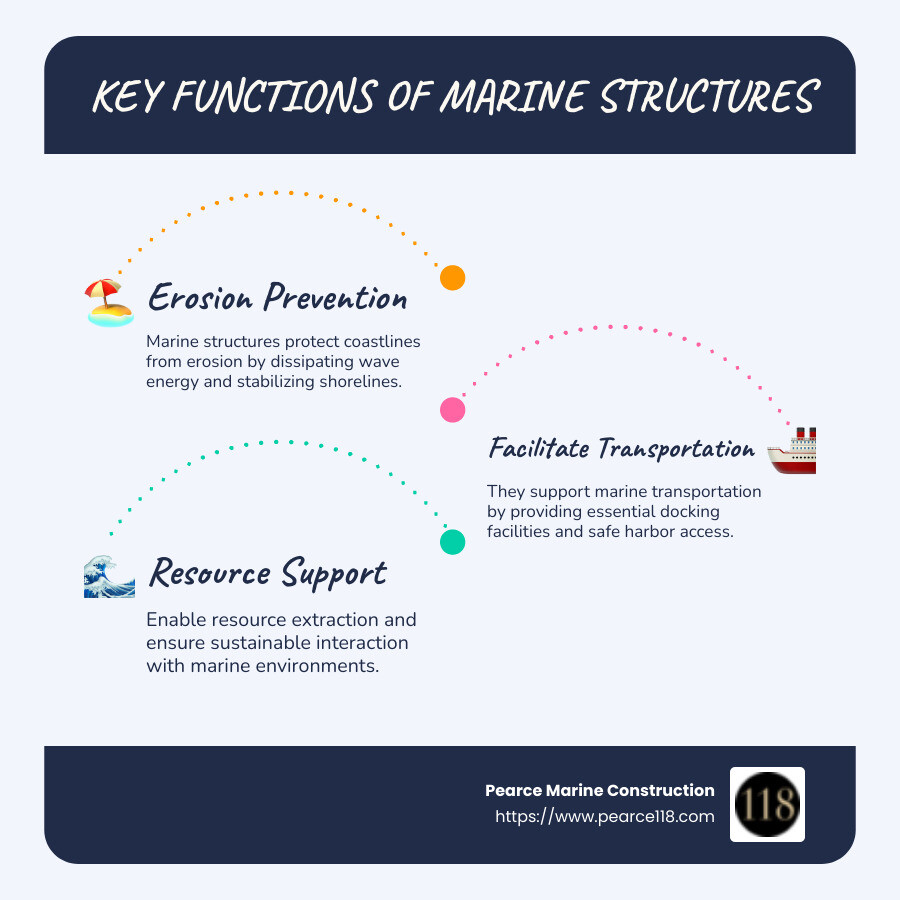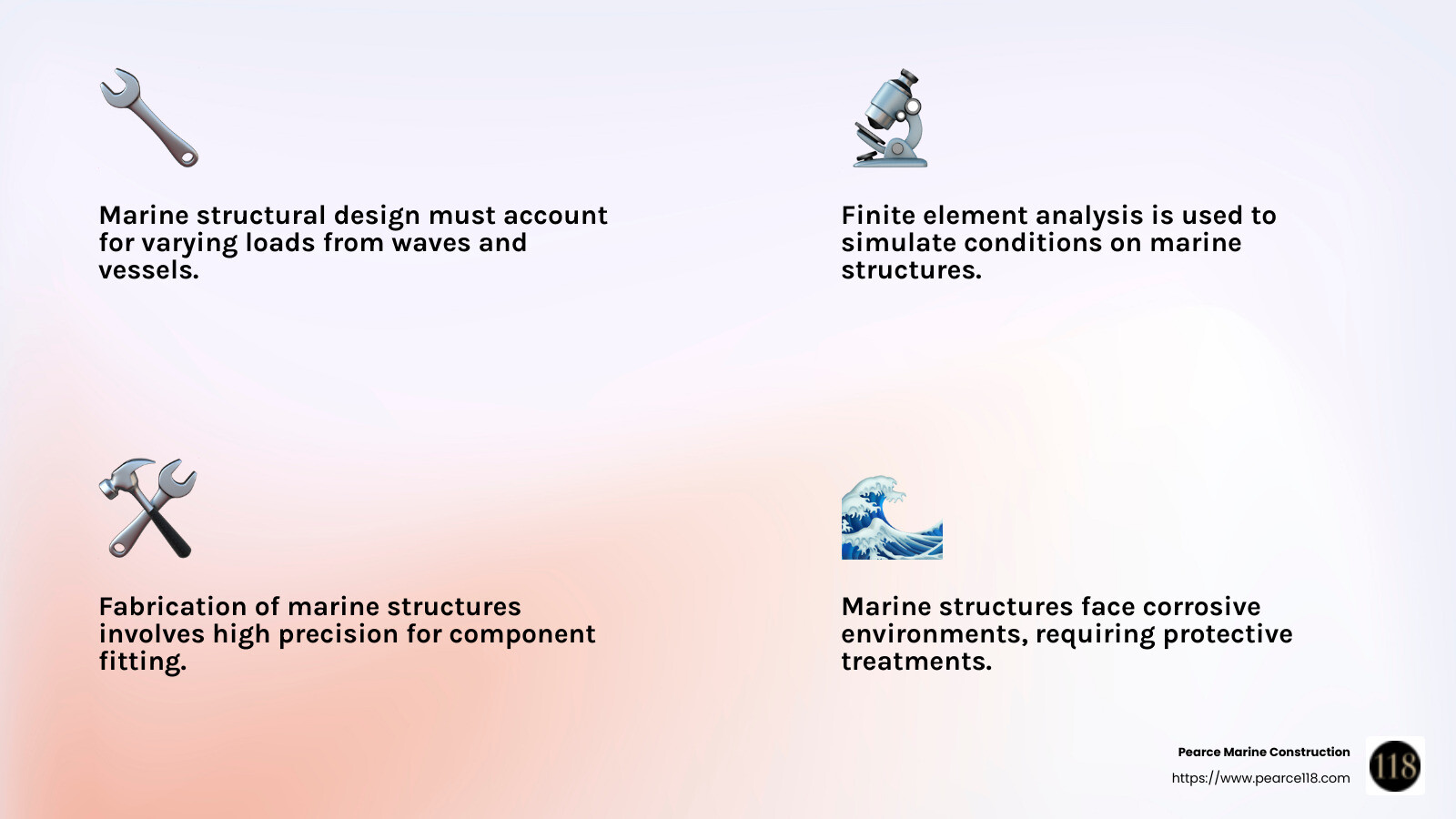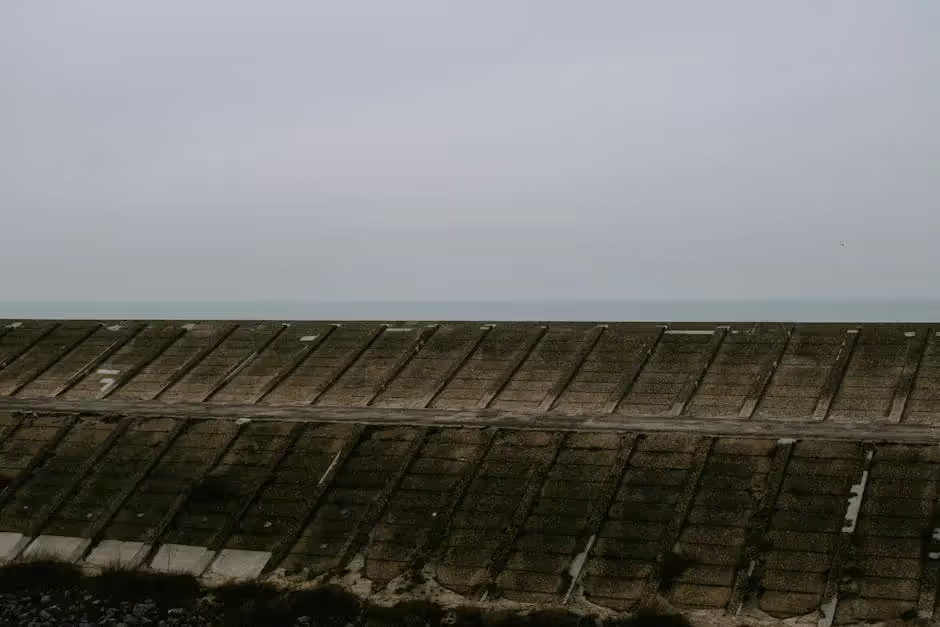Marine Structures Explained: From Pile Driving to Dock Construction

Marine structures are essential components of our built environment that interact directly with coastal zones and open oceans. They comprise a variety of engineering facilities that harness and protect marine resources while addressing shoreline erosion and flooding issues. Examples include docks, bulkheads, and decks, which provide stability and function to harbors and waterfront properties.
- Marine structures are integral to managing coastal zones and open oceans. They help prevent erosion, facilitate marine transportation, and support resource extraction.
- Critical for safe and effective interaction with marine environments, these structures need to be durable and well-designed.
- From construction to ongoing maintenance, marine structures play a key role in preserving our coasts while enabling human activities.
Designing and constructing these facilities involve overcoming challenges posed by harsh marine environments, such as high loads and corrosive conditions. Therefore, meticulous craftsmanship and innovative engineering solutions are key to their success. Understanding these structures is vital for property owners on Long Island seeking reliable solutions for their marine and coastal applications.

Easy marine structures word list:
Types of Marine Structures
Marine structures play a crucial role in both protecting and utilizing coastal zones and open oceans. They come in various forms, each serving specific purposes. Let's explore some of the most common types.
Quays and Wharfs
Quays and wharfs are essential for handling cargo and passenger vessels. They provide a solid platform where ships can dock and transfer goods or passengers. These structures are typically built parallel to the shoreline, offering easy access to land transportation networks.
Jetties and Piers
Jetties extend from the shore into the water, serving as a barrier to protect harbors from waves and sediment. They help maintain navigable channels by preventing sand build-up. Piers, on the other hand, are built on piles and extend over the water, providing docking space for boats and recreational areas for fishing and sightseeing.
Anchor and Mooring Buoys
Anchor buoys mark the location of an anchor on the seabed, helping vessels locate their anchoring points. Mooring buoys are floating devices that ships can tie onto, providing a stable point to secure a vessel without anchoring. They are crucial for reducing congestion in busy harbors.
Docks and Bulkheads
Docks are structures where boats are moored. They can be floating or fixed and are essential for loading and unloading goods. Bulkheads act as retaining walls, preventing soil erosion and protecting waterfront properties from wave action. They are vital for maintaining the integrity of coastlines.
Decks
Decks are flat surfaces that extend over the water, providing recreational space and access to water activities. They are common in marinas and residential waterfront properties, offering a place for leisure and relaxation.
Shoreline Protection
Shoreline protection structures like seawalls and revetments help prevent erosion and flooding. They protect coastal areas from storm surges and high waves, ensuring the safety of properties and infrastructure. These solutions are essential in areas prone to severe weather conditions.
_compressed.webp)
Understanding these various marine structures is key for anyone involved in coastal development or looking to improve their waterfront property. Each type serves a unique purpose, contributing to the safety, functionality, and enjoyment of marine environments.
Next, we will dig into the process of pile driving, a crucial step in constructing many of these marine structures.
The Process of Pile Driving
Pile driving is a fundamental process in building many marine structures. It involves driving long columns, or piles, into the ground to provide foundational support for structures like piers, docks, and jetties. Let's break down the key components of this process.
Construction Phases
The pile driving process unfolds in several phases:
Site Assessment: Before any construction begins, engineers assess the site. They check soil conditions, water depth, and environmental factors to determine the best type of pile to use.
Planning and Design: In this phase, engineers design the pile layout. They decide on the number, length, and material of piles needed to support the structure.
Mobilization: Equipment and materials are brought to the site. This includes pile drivers, cranes, and the piles themselves.
Driving the Piles: This is the main phase where piles are driven into the ground using a pile driver. The driver uses heavy weights to hammer the piles into the seabed or ground. This phase requires precision to ensure piles are correctly positioned and driven to the right depth.
Inspection and Testing: Once the piles are in place, they are inspected to ensure they meet design specifications. Testing may include checking the load-bearing capacity of the piles.
Spatial Subsystems
In pile driving, spatial subsystems refer to the different areas of the construction site that need to be managed. This includes:
- Onshore Areas: Where equipment and materials are stored and prepared.
- Offshore Zones: The actual site where piles are driven. This area requires careful coordination to avoid disturbing marine life and the surrounding environment.
Temporal Phases
The temporal phases of pile driving involve timing and sequencing:
- Preparation Phase: Timing is crucial for mobilizing resources and preparing the site.
- Execution Phase: This phase involves the actual driving of piles. It must be carefully timed to align with tides and weather conditions.
- Completion Phase: Involves finishing touches and ensuring all piles are secure and ready for the next construction steps.
Project States
Throughout the pile driving process, the project moves through different states:
- Initial State: Planning and preparation stages.
- Active State: Pile driving is actively taking place.
- Final State: Completion of pile driving, ready for the next construction phase.
Understanding these phases and subsystems is vital for the success of any marine construction project. Proper planning and execution ensure the stability and longevity of the marine structures being built.
Next, we will explore dock construction techniques, including the use of innovative materials and design strategies.
Dock Construction Techniques
Building docks involves more than just putting together a few planks. It's a complex process that uses a variety of materials and techniques to ensure durability and functionality. Let's explore some of these dock construction techniques.
Concrete Structures
Concrete is a popular choice for dock construction due to its strength and durability. It's especially useful in areas with harsh weather conditions and heavy use. Concrete docks are built using reinforced concrete, which includes steel bars or mesh to add strength and prevent cracking.
- Benefits: Long-lasting, low maintenance, and resistant to water and weather damage.
- Drawbacks: Can be more expensive and requires skilled labor for installation.
Steel Reinforcement
Steel is often used alongside concrete to provide additional support. Steel reinforcement helps docks withstand heavy loads and prevents them from shifting or sinking over time.
- Benefits: Adds strength and stability to the dock structure.
- Drawbacks: Susceptible to corrosion if not properly treated or maintained.
Bio-Improved Materials
In recent years, there's been a push towards using bio-improved materials in dock construction. These materials are designed to be more environmentally friendly while maintaining strength and durability.
- Benefits: Eco-friendly and can help promote marine life growth around the dock.
- Drawbacks: May have higher initial costs and require specialized installation techniques.
ECOncrete®
ECOncrete® is a type of concrete designed to promote marine life. It incorporates textures and designs that encourage the growth of organisms like algae and barnacles. This not only helps the environment but also improves the dock's durability by creating a natural protective layer.
- Benefits: Improves marine biodiversity and increases the lifespan of the structure.
- Drawbacks: Can be more expensive and requires specific design considerations.
COASTALOCK
COASTALOCK is a modular system used in dock construction. It allows for easy assembly and disassembly, making it ideal for temporary structures or areas prone to environmental changes.
- Benefits: Flexible, easy to install, and adaptable to different environments.
- Drawbacks: May not be as robust as permanent structures.
Each of these techniques and materials offers unique advantages, making them suitable for different dock construction needs. Whether prioritizing environmental impact, durability, or flexibility, there's a solution available to meet the specific requirements of your project.
Next, we'll dig into marine structural engineering, exploring the design and testing processes that ensure these structures can withstand the demanding marine environment.
Marine Structural Engineering
When it comes to marine structures, engineering is at the heart of creating resilient and long-lasting facilities. This involves a detailed process of structural design, analysis, fabrication, and testing. Each step is crucial to ensure these structures can handle high-load applications and corrosive environments.
Structural Design and Analysis
The first step in marine structural engineering is structural design. Engineers develop detailed plans that outline how structures like docks, jetties, and bulkheads will be built. These designs must account for the unique challenges of marine environments, such as constant exposure to water and varying loads from waves and vessels.
Following design, analysis is performed using high-fidelity finite element analysis. This technique allows engineers to simulate how structures will behave under different conditions, ensuring they meet safety and performance standards.
Fabrication and Testing
Once the design and analysis are complete, the next step is fabrication. This involves constructing the components of the structure, often using materials like concrete and steel. Fabrication must be precise to ensure all parts fit together perfectly.
After fabrication, rigorous testing is conducted. This includes large-scale structural testing to verify that the structure can withstand expected loads and environmental conditions. Testing ensures the structure's fitness-for-service, meaning it can operate safely and effectively throughout its intended lifespan.
High-Load Applications and Corrosive Environments
Marine structures often face high-load applications, such as supporting heavy vessels or withstanding powerful ocean currents. To handle these demands, engineers use materials and designs that maximize strength and stability.
Additionally, marine environments are inherently corrosive. Saltwater, wind, and weather can wear down materials over time. To combat this, structures are often treated with protective coatings or made from corrosion-resistant materials.
Fitness-for-Service and Pressure Vessel Design
Fitness-for-service assessments are conducted to ensure that structures remain safe and functional over time. These assessments evaluate the condition of a structure and determine if any repairs or modifications are needed.
In some cases, marine structures may include pressure vessels, such as those used in underwater habitats or oil and gas applications. Designing these vessels involves ensuring they can withstand the immense pressures found underwater.
Structure Health Monitoring and Failure Analysis
To maintain the integrity of marine structures, ongoing structure health monitoring is essential. This involves using sensors and other technologies to track the condition of the structure in real-time. Monitoring helps identify potential issues before they become critical.
If a failure does occur, a thorough failure analysis is conducted. This process investigates the cause of the failure and develops solutions to prevent similar issues in the future. It’s a vital part of ensuring the safety and reliability of marine structures.

In the next section, we’ll address some frequently asked questions about marine structures, helping you understand more about their design, construction, and maintenance.
Frequently Asked Questions about Marine Structures
What are the marine structures?
Marine structures are engineering facilities designed to function in coastal zones and open oceans. These structures include quays, wharfs, jetties, piers, docks, and bulkheads. Each serves a specific purpose, whether it's for transportation, recreation, or protecting the shoreline.
Marine structures are crucial for managing and utilizing marine resources effectively. They provide essential infrastructure for fishing, shipping, and tourism, helping to maintain economic and social activities along coastlines.
What are the structures of the maritime?
In maritime engineering, structures are often organized into spatial subsystems and temporal phases. Spatial subsystems refer to the different parts of a marine structure, such as the foundation, superstructure, and auxiliary facilities. Each subsystem must be carefully designed and constructed to ensure the overall stability and functionality of the structure.
Temporal phases involve the various stages of a project, from planning and design to construction and maintenance. Each phase requires detailed attention to ensure that the project progresses smoothly and meets all safety and performance standards.
Project states are the conditions or statuses of a marine project at different points in time. This can include the initial concept, active construction, or ongoing maintenance.
What does a marine structural engineer do?
A marine structural engineer plays a vital role in the creation and maintenance of marine structures. Their work spans port projects, offshore projects, and waterfront projects. They are responsible for designing structures that can withstand harsh marine conditions and meet the specific needs of each project.
For port projects, engineers design facilities that accommodate cargo handling and passenger services. These projects must consider factors like tidal movements and ship sizes.
In offshore projects, such as oil rigs or wind farms, engineers ensure structures can endure extreme weather and ocean conditions. These projects often involve advanced technologies and materials to improve durability.
Waterfront projects often focus on enhancing public access to water while providing flood protection. Engineers design bulkheads, levees, and other barriers to protect against rising sea levels and storm surges.
In the next section, we'll dive deeper into the materials and techniques used in dock construction, highlighting innovations that improve durability and sustainability.
Conclusion
At Pearce Marine Construction, we take immense pride in our generational expertise and meticulous craftsmanship. As a woman-owned business, we have been serving the communities of Nassau and Suffolk County with dedication and precision for many years. Our deep-rooted knowledge, passed down through generations, allows us to tackle even the most complex marine construction projects with ease.
Our commitment to quality is evident in every project we undertake. From bulkheads to docks and shoreline protection, we ensure that our constructions are built to last. This dedication to excellence not only improves the beauty and functionality of waterfront properties but also provides peace of mind to our clients.
Living by the water presents unique challenges, such as erosion and flooding. Our team understands these challenges and works diligently to deliver solutions that safeguard your property while enhancing its value and usability.
As we continue to serve the beautiful regions of Nassau and Suffolk County, we remain focused on maintaining the high standards that have become synonymous with Pearce Marine Construction. We invite you to explore our services and let us help transform your waterfront property into a space that meets all your needs.
Thank you for considering us for your marine construction projects. We look forward to bringing our expertise and craftsmanship to your next venture.
Bring Your Vision to Life
Whether you're planning a custom dock, seawall, or boat lift, our experienced team is ready to deliver high-quality marine construction tailored to your needs. Pearce Marine Construction brings craftsmanship, precision, and a deep understanding of Florida’s waterways to every project. Let us help you create a durable, beautiful solution that stands the test of time. Get in touch now for a personalized estimate!


%20(2)%20(1)%20(1).avif)
